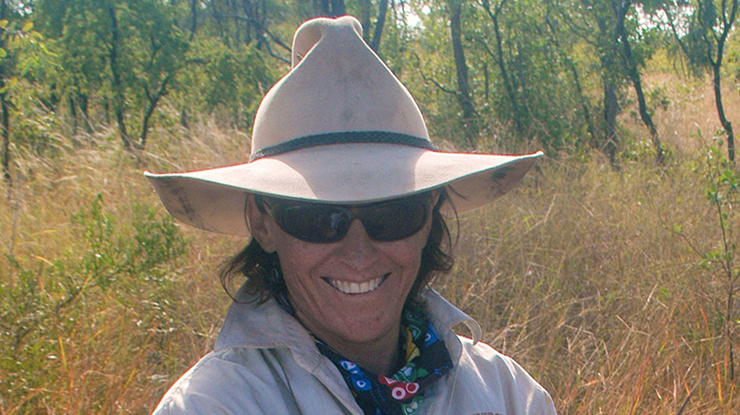 Dionne Walsh
Dionne Walsh
For producers in the northern rangelands, there's no better time than the second half of the dry season to put in place feedbase and herd management strategies which will maximise production into the wet season and beyond.
MLA's Northern Breeding Business (NB2) feedbase lead and Managing Director of Range IQ, Dionne Walsh, said making decisions now around managing the feedbase and stocking rates is crucial for producers wanting to get set for a productive year ahead.
Let it rest
One important decision producers need to make as the dry season draws to a close is around how wet season spelling of paddocks could help improve productivity in following seasons.
"Pasture spelling is most effective over the growing season – that's when your pastures can actually respond to a period free of grazing," Dionne said.
"Spelling over the wet season is a good strategy to improve land condition, and it's also ideal for producers who may want to build up a large body of feed that they'll then be able to use during the next year."
She said the timing around the spelling of paddocks is especially important to get the most out of pastures.
"It can be tricky to decide when to take cattle out of a paddock to get ready for a wet season spell – on very large properties, this decision often comes down to when it is most practical to empty a paddock.
"Sometimes this means you need to destock a paddock earlier than you would ideally like, but in other cases you may be able to delay destocking so you can use the available feed right up to the wet season."
Restocking of paddocks after spelling also needs to be planned strategically to maximise the pasture response. Options include:
- spell the paddock for the first part of the growing season, which is the most crucial time for getting a good pasture response, or
- leave it completely destocked for the entire wet season to allow pastures to set seed and put livestock back in next year as part of the normal first-round muster.
Be strategic with supply
At this point in the dry season, Dionne said it's vital producers also begin to consider how they would manage paddocks to meet the nutritional needs of breeders during late pregnancy and lactation.
"Many producers now conduct pregnancy diagnosis and foetal aging to segregate cohorts of breeders into tighter calving groups," Dionne said.
"Now's the time when you should think about where you're going to put pregnant breeders so they'll have good nutrition through that really demanding time of late pregnancy and lactation."
Allocating productive paddocks that have been spelled to pregnant heifers is one approach Dionne endorses to ensure these young breeders – and their progeny – have a strong feed supply into the wet.
"Young breeders have very high nutritional demands because they are growing at the same time as they are pregnant and lactating," Dionne said.
"Some producers keep good quality paddocks aside to put this important cohort into ahead of calving. This way, they know they will have enough feed to carry them right through until there's a good body of new green feed coming on once they're lactating."
Taking stock
The mid to late dry season is also a key time to make decisions around how stocking rates should be adjusted to maintain sufficient feed supply through to the wet season and beyond.
"Around this time, producers should be doing another check of their paddocks just to see how their feed supply is travelling and whether they are going to have enough good quality feed to last them through to their next production point date," Dionne said.
"You may need to adjust your forage budget in case there's been any dramatic change in any of your paddocks due to unexpected events such as spoiling rain, a grasshopper outbreak or a bushfire.
"If the pasture quality or amount has declined unexpectedly, you might need to reduce your stocking rates in a paddock or see if you have spare capacity elsewhere, so the feed supply doesn't reach critical levels prior to the wet season."
Dionne said maintaining an adequate feed supply is also essential to ensure pastures can respond effectively to wet season rain and remain productive for seasons to come.
"You don't want perennial grass tussocks to be grazed down to ground level, because it damages their growing points and makes it really hard for them to respond to early wet season rainfall," Dionne said.
"To retain a healthy perennial grass tussock, you shouldn't graze these grasses any lower than 10–15cm in height.
"This will also ensure you can retain good groundcover coming into the wet season to avoid runoff and erosion, which can have a long-term effect on your pastures and soils."
Predictions for planning
These management decisions should be made with the forecast seasonal conditions always in mind to ensure the most profitable outcomes.
For northern producers, this hinges on keeping a close eye later in the year on the predicted wet season onset.
"If it looks like the wet season will have a late onset, then you might have to make some decisions earlier about lightening off some paddocks or changing your plans for wet season spelling if you're worried that the feed supply is going to be tight at the end of the year," Dionne said.
"Alternatively, if there's strong indications that the wet season is going to start early or they're predicting an above-average rainfall season, you might have more confidence to set aside paddocks for a wet season spell.
"A bumper season is a great opportunity to lift land condition and optimise live weight production – and planning your wet season strategies ahead of time ensures you can capitalise on these opportunities."






